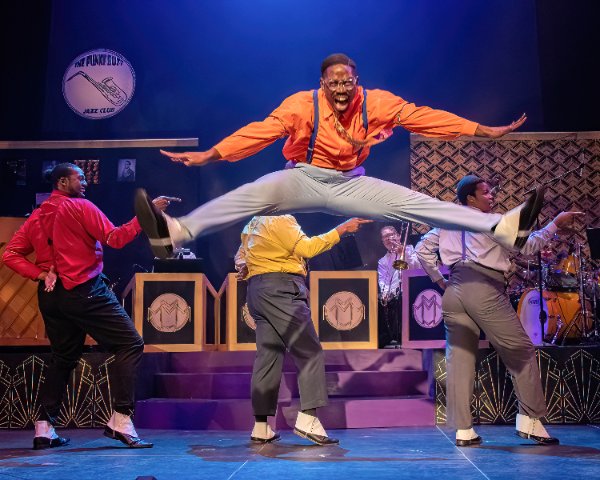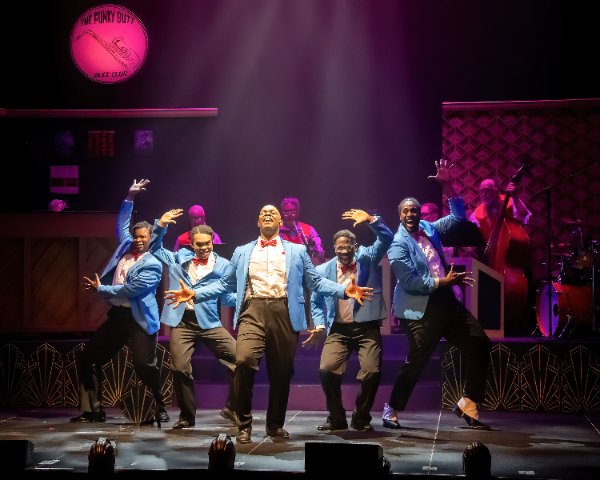Five Guys Named Moe
MNM Theatre Company in South Florida
By: Aaron Krause - Sep 12, 2023
Art’s healing power, and its ability to affect change, are hardly secrets. So, you can understand why the “Five Moes” in the acclaimed musical revue, Five Guys Named Moe believe that, through their music, they can make a difference in Nomax’s pathetic life.
Of course, it’s not the titular characters’ music that is front and center in Five Guys Named Moe. Rather, the songs in the show became popular largely because late real-life music legend Louis Jordan (1908-1975) sang and/or created them.
Although nobody mentions his name in the piece, the show is largely a love letter to Jordan’s music. And his fans will be happy to learn that South Florida’s MNM Theatre Company is performing the musical revue with passion. The company’s high-octane and believable production runs through Sept. 24. Performances take place in the Rinker Playhouse. Its location is within the Raymond F. Kravis Center for the Performing Arts in West Palm Beach.
As you may know, Jordan was a key figure in the development of rhythm and blues as well as rock and roll. The bouncing, rhythmic energy of his music, together with smart lyrics and a charismatic stage presence, proved a winning combination for Jordan. Such characteristics helped him become one of the few African American artists of the 1940s to enjoy crossover popularity with white audiences. Jordan was a pioneering songwriter and bandleader. In fact, many knew him as “The King of the Jukebox.” And his new slant on jazz music helped pave the way for rock and roll in the 1950s.
MNM Theatre Company has assembled a fine cast to bring the show to life. The company’s mission is to “produce inspiring, exciting, and high-quality professional theater while using Florida-based talent,”
Under Jacquez Linder-Long’s vibrant, creative direction and acrobatic choreography, the cast members shine. They kick, spin, jump, hum, croon, and belt their way through more than 20 of Jordan’s hit songs.
Each performer creates a distinct, believable, and energetic character. Cast members are Doriyan De’Angelo Caty as Eat Moe, Leo Jasper Davis as Big Moe, TJ Pursley as Little Moe, Don Seward as No Moe, Michael L. Wallace as Four-Eyed Moe, James White III as Nomax, and Desir Dumerjuste as the production’s Swing. The cast members succeed individually and as members of an ensemble.
The titular characters and Nomax create some semblance of a plot. And the show is a fun-filled, vigorous, and loving tribute to a musical legend. For more than two hours, you will forget your troubles. Instead of ruminating on our troubled world, you may clap, snap, or even dance along with cast members to Jordan’s catchy, engaging music.
Five Guys Named Moe involves audience participation. In particular, the performers interact with audience members and even teach them a dance. So, if you are the shy type, consider yourselves warned.
Nomax is hardly in the mood for merriment. He is a down-on-his-luck, aimless fella. His wife has just left him, and he suffers from a case of the blues. When the show starts, it’s 5 a.m. Nomax is listening to the radio. Suddenly, the five guys who share the name “Moe” materialize from seemingly nowhere. They have arrived to help Nomax get his life back on track. To do that, the men sing and dance to many of Jordan’s songs. The musical numbers range in topic and theme from relationships to farm life to the railroad and the disadvantages of drinking too much.
Some songs serve the story better than others. For instance, “Messy Bessy” is a number about a woman who drinks too much. Nomax wonders why the titular characters sing the song to him. After all, his wife, Lorraine, (an offstage character) does not drink alcohol.
“So, who’s the Messy Bessy in your house?” the men ask Nomax, implying that he’s the one in his household who drinks too much.
The Moes also confront Nomax about his drinking problem in “What’s the Use of Getting Sober When You’re Gonna Get Drunk Again.”
While the aforementioned songs make sense within the context of the musical revue, the inclusion of others is questionable. Indeed, you may wonder why librettist Clarke Peters included songs such as “Ain’t Nobody Here But Us Chickens,” and ”Choo Choo Ch’Boogie.”
In the former, a farmer locks up his barnyard and wonders about the source of the noise emanating from nearby. As it turns out, “there ain’t nobody here but us chickens,” as the lyrics go. The farmer couldn’t recognize sounds from his own animals? And what does the song have to do with Nomax’s life? Peters included the song as part of the show-within-a-show. At one point, the titular characters inform Nomax that they have a show to perform at a venue called the “Funky Butt Club.” Nomax accompanies them and sits rapt while the quintet performs songs such as the one about the farmer, as well as “Choo Choo Ch’Boogie.” The latter is a fun song with especially clever rhymes taking place around train tracks.
The lyrics, in part, go: “I’m tired of transportation in the back of a hack, I love to hear the rhythm of the clickety-clack, and hear the lonesome whistle, see the smoke from the stack, and pal around with democratic fellas named Mac, so take me right back to the track, Jack.”
Hearing such rhymes is part of the fun in Five Guys Named Moe. Also, the songs are varied; some are rousing and upbeat, while others are quieter, contemplative, and affecting.
A weakness in the show is that we learn too little about Nomax. Indeed, we are more likely to care about and pull for a well-developed character with traits which make him identifiable. Perhaps learning a few more details about Nomax would help us pull for him more. However, the lack of character development in Five Guys Named Moe has not hurt the show’s popularity. The legendary Cameron Mackintosh originally produced the piece in London’s West End. In 1992, the show moved to Broadway, where it received Tony Award nominations.
Just as the actors perform believably and with verve, the backstage artists contribute significantly to the production’s success. For instance, scenic designer Jordon Armstrong has created a minimal set that is specific enough to place us in settings such as Nomax’s house and a bar. The set includes period detail, such as an old-time radio, and pictures of music stars on the walls help to set the mood for the show. In addition, a gorgeous mural of musicians serves as a backdrop to a stand-alone bar. Speaking of the drinking establishment, it’s not clear whether it is part of Nomax’s house or a separate location.
Also behind the scenes, lighting designer Karalyn Fitzgerald’s color palette effectively establishes mood. For instance, the artist uses dimmer lighting to reinforce a romantic aura. Brighter, more intense lighting appropriately bathes the stage during more upbeat numbers.
Meanwhile, costume designer Belicia Linder-Long has created visually appealing costumes. They help establish the Moes as part of the same group. Indeed, at one point, their matching blue jackets, white shirts, and red bowties unite the men and define them as performers who wish to look their best for their audiences.
Nomax’s costumes, which include a sleeveless white shirt, help to differentiate him from the Five Moes. However, Nomax’s clothes change during the show, symbolizing his change of character. In particular, as he grows from an apathetic, stumbling drunk to a more content, refined and relaxed individual, his clothes become more tasteful.
As Nomax, White transforms seamlessly from a sad, unsteady, drunken and apathetic individual to an engaged, enthusiastic person who is calm, confident, and in control of himself. It’s almost as though we see two different individuals throughout the course of the show.
In the final analysis, in addition to its catchy music and fun moments of audience participation, Five Guys Named Moe is a loving, buoyant celebration of a musical legend — and a rejuvenating reminder of art’s power to make a difference.
MNM’s production of Five Guys Named Moe runs through Sept. 24 in The Rinker Playhouse at the Raymond F. Kravis Center for the Performing Arts, 701 Okeechobee Blvd. in West Palm Beach. Performances are at 7 p.m. Friday and Saturday, as well as 1:30 p.m. on Saturday and Sunday. Ticket prices range from $45-$55. For tickets, go to kravis.org, or call (561) 832-7469. For group sales, call (561) 651-4438 or (561) 651-4304.


